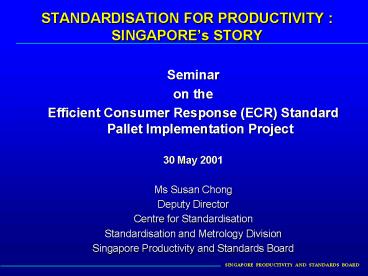STANDARDISATION FOR PRODUCTIVITY : SINGAPOREs STORY PowerPoint PPT Presentation
1 / 15
Title: STANDARDISATION FOR PRODUCTIVITY : SINGAPOREs STORY
1
STANDARDISATION FOR PRODUCTIVITY SINGAPOREs
STORY
- Seminar
- on the
- Efficient Consumer Response (ECR) Standard Pallet
Implementation Project - 30 May 2001
- Ms Susan Chong
- Deputy Director
- Centre for Standardisation
- Standardisation and Metrology Division
- Singapore Productivity and Standards Board
2
NATIONAL STANDARDISATION PROGRAMME
- Strategic Intent
- To be one of the global standardisation leaders
through excellence in the use of standardisation
to - facilitate trade and improve environment, health
and safety - improve productivity through the deployment of
standardisation practices and harmonisation of
standards - transfer and create knowledge by leveraging on
standards - for the social and economic betterment of
business, industry consumers in Singapore
3
STANDARDISATION FOR PRODUCTIVITY
- Increased emphasis on standardisation as tool to
enhance the competitiveness of industry - Increased efforts to facilitate the
implementation of national standards as well as
industry standards practices - Standards Implementation for Productivity(SIP)
commenced as programme in 1997 - Industry Productivity Fund available for pilots
feasibility studies
4
Standards with High Impact on Interoperability
- Pallet Standard for the Fast Moving Consumers
Goods (FMCG) Industry- 1st SIP - Pallet standardisation maximises asset
utilization by - providing interoperability along the supply chain
- eliminating the need for manual transfer of goods
to another pallet and thus raise productivity - leading to a reduction in delivery and transfer
costs - allowing standardisation of racking and warehouse
design for economy of space and facilitate
automation - Pilot study completed in Yr 2000 resulting in
155 IRR - 65,000 standard pallets currently in use
5
Standards with High Impact on Interoperability
- Logistics - Radio Frequency Communication
Protocol for Electronic Seal of Freight
Containers - Developed by ISO WG led by Singapore
- Ensures interoperability along logistics supply
chain - Enhances productivity increases cost savings
from manpower time savings - Reduces claims liabilities, enhances security
more accurate tracking of container movements - ISO standard completion expected in 2002
6
Standards with High Impact on Quality
Productivity
- Technical Reference for Cold Chain Management -
Milk and Diary Products(TR2 2000) - Improvement in
- the quality of milk diary products sold and
safety in the consumption of these products - the efficiency and productivity of the supply
chain, which would result in higher sales with
higher consumer confidence - integrity of cold chain management at critical
points - SIP commenced in Apr 2001 with ECR Singapore as
project manager. - key stakeholders NTUC FairPrice, Cold Storage,
Carrrefour Shop Save as well as 4 suppliers
7
Construction IT Standards for Interoperability
- The development of IT standards
- is in line with the Construction 21 Committees
aims to promote the use of IT - enables the efficient exchange of electronic
information between the various professionals
namely, developers, architects, engineering
consultants, contractors quantity surveyors.
8
Construction IT Standards for Interoperability
- Code of Practice for Classification of
Construction Cost Information (CP 80 1999) - With one classification system, this code will
help to improve productivity by - - reducing duplicative work
- - improving interoperability significantly for
the industry - - expediting work process minimising errors in
interpretation - Expected to be used by property developers,
architects, mechanical electrical engineers,
civil structural engineers, quantity surveyors
contractors
9
Construction IT Standards for Interoperabilty
- Code of Practice for Construction Computer Aided
design on the Organisation and Naming of CAD
Layers (CP 83 Part 1 1999) - The intent of the code is to
- - aid communication of technical documentation
on CAD systems in the construction industry - - improve interoperability
- The code covers
- - the general principles of the layer structure
within CAD files - - the organisation allocation of layers that
are used in CAD files for building
construction projects
10
Standards with High Impact on Interoperability
- Technical Reference for Pipeline Service
Corridors - Productivity would be improved through
- the provision of centralised utilities common
pipeline service corridors for liquid gaseous
materials - the use of the same standard for external
pipelines of all plants - facilitating safe transfer of raw materials,
finished products utilities outside the
boundaries of the plants
11
Standards with High Impact on Productivity
- Technical Reference on Cleaning Performance for
Commercial Buildings (TR 1 1999) - First service standard that provides an objective
system as basis to determine standard of cleaning
services according to customers requirements - Performance-based that provides service providers
the incentive to invest in automation training
to improve productivity competitiveness
12
Standards with High Impact on Interoperability
- RosettaNet Standards for Collaborative Commerce
- RosettaNet Singapore, non profit standardisation
organisation, launched on 29 Sept 2000 - Addresses global interoperability needs of
infocomm, electronic components semiconductor
industry - Consortia standards used based on international
standards - Current emphasis on product information, order
management, inventory management marketing
information management - E competency centre to be established to serve
local regional needs
13
Potential SIP projects
- TR for Cold Chain for Milk Dairy Products
- Roll Cages for FMCG industry
- TR for Exhibition Management Services-Safety,
Health Operational Efficiency - TR for Cleaning Performance standards
- TR for Medical Devices
14
Standardisation for Productivity
- What you can do if you wish to initiate more SIP
projects - Fill in the new standards request form posted on
the front page of the PSB website at
www.psb.gov.sg or the standards website
www.standards.org.sg send it in to the Centre
for Standardisation - Call us at Tel 8701 117 or send e mail to
cfs.gov.sg for a discussion on your needs
15
Standardisation for Productivity
- Thank you

